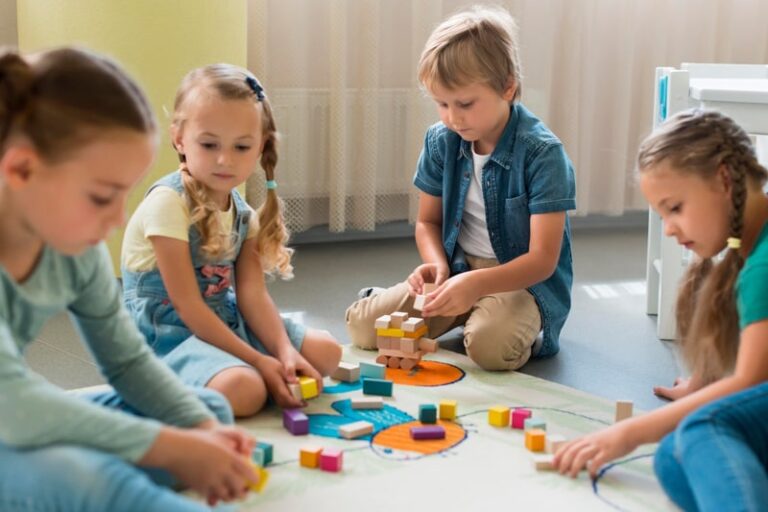What is Game-Based Learning?
Game-based learning incorporates games in order to improve learning outcomes in children.

Author
Jill Padfield
Published:
Nov 2024

Key takeaways
- There are two forms of game-based learning – Digital game-based learning involves the use of computer games. Traditional game-based learning uses non-digital games, like cards.
- Be creative – There are many types of game-based learning. Used correctly, they can be adapted to suit children of all ages and abilities.
- Game-based learning develops life skills – Children are actively involved in game-based learning. This boosts problem-solving and critical-thinking skills.
Imagine you’re in a classroom. The teacher is standing in front of a whiteboard writing. The room is silent as students take notes in their seats.
Now, imagine the same teacher splitting the class into two teams. One student from each team is given a word and told to perform actions associated with that word. In each round, a different student is given a word for the rest of the team to guess. The team with the most correct guesses wins. Sounds more exciting, doesn’t it?
Not only is game-based learning exciting, it allows children to actively take part in their learning.
Table of contents
What is game-based learning?
Game-based learning combines the fun of games with specific learning goals. It encourages children to use their own initiative to think through possible solutions.
Using games in learning can foster healthy competition between students. Computer games are one of the most popular activities among children today. But, there is still more room for research to highlight the positive impacts that digital game-based learning can have on students. However, it’s believed that game-based learning can also increase learner engagement and the motivation to succeed.
Game-based learning often includes competitive elements or an interactive storyline to engage students.
Game-based learning vs. gamification
Game-based learning and gamification both involve using games for educational purposes. However, there are subtle differences between them.
Gamification uses game elements to complement traditional learning methods. These can include:
- Leaderboards
- Points systems
- Achievement badges
Game-based learning consists of activities or games that are designed to be the learning experience. For example, children can learn Spanish words by playing an adapted game of Bingo.
Turn math into playtime with DreamBox Math
DREAMBOX MATH
Get started for FREE today!

Types of game-based learning
Many people think that game-based learning is simply using computer games in a classroom. However, it comes in many different forms, all designed to make learning more fun for children.
Below are the two main types of game-based learning.
Digital game-based learning
We know that many kids love spending hours on the computer playing games. Digital game-based learning adds elements of computer games, such as design and choice. There are four main ways to include digital game-based learning in the classroom.
- Using commercial computer games to aid learning
- Developing unique games for the sole purpose of teaching educational concepts
- Getting children involved in game design
- Adding game-based elements to learning activities, such as scoreboards.
Traditional game-based learning
Traditional game-based learning involves the use of non-digital games, such as board games. Most traditional games are simple to play and don’t need any technical equipment. So, they can be very beneficial, both in the classroom and at home.
1. Card games
Cards can be amazing tools to reinforce educational outcomes. For example, playing cards can be used to build basic math skills or teach pattern matching.
2. Board games
Board games are played on a specific board and involve moving pieces to achieve a certain goal. For example, Monopoly can be used to teach strategic thinking and money management. There are hundreds of board games to choose from including chess, The Game of Life, and checkers.
3. Simulation games
Computer simulations closely resemble real world scenarios in a virtual environment. Sims and Minecraft are two of the most well-known simulation games. They involve building and exploring virtual worlds, which can boost children’s creativity.
4. Role-playing games
Role-playing games allow educators to introduce children to real-life situations. This teaches them valuable skills such as teamwork and negotiation. Role-playing games also help children develop empathy when playing a different character.
5. Word games
Word games teach the basics and properties of language. Scrabble is an excellent word game that can have many uses in a classroom. For example, children can play it the traditional way, or they can be given a certain number of letter tiles to see how many words they can make.
6. Video games
Research shows that 90% of children over 2 years old play video games, with over 3/4 of American households owning a game console. Video games involve the use of a joystick, keyboard, or controller to manipulate objects on a screen. Popular games include classic Pac-Man and the more modern Fortnite.
7. Puzzle games
In puzzle games, children need to look at a problem from different perspectives to get to the correct answer. Puzzle-based games generally involve concepts like:
- Spatial and shape recognition
- Logical thinking
- Word completion
- Sequence pattern solving
- Math problems
Popular puzzle games include Sudoku, 2048, and Tetris.

The math program that drives results
Get started today!
DreamBox adapts to your child’s level and learning needs, ensuring they are appropriately challenged and get confidence-building wins.
Five benefits of game-based learning
There are multiple benefits to gamed-based learning. Here’s a look at the top five:
Helps with problem-solving
Game-based learning encourages children to find solutions to problems as they arise. They also foster skills that children can use in real-life situations, such as teamwork and decision-making.
Develops critical thinking skills
Studies show that game-based learning can significantly improve critical thinking skills in children. Many games encourage children to assess a situation from multiple angles and learn from their mistakes.
Increases learner engagement and intrinsic motivation
Many games involve teamwork and/or competition among students. They also encourage children to persist at a problem because there is a natural fun element to games. A 2019 study showed that games involving feedback, collaboration, and creativity significantly improved student engagement and motivation.
Provides support for students with special needs
Every student is unique in their approach to learning. Some prefer to learn visually, while others like to get more hands-on. Games can easily be adjusted to support the learning needs of all students. For example, children can be taught new math concepts through a Wheel of Fortune game. Game-based learning has been proven to raise test scores and foster a positive learning environment for all students.
Contributes to social learning
Game-based learning encourages children to interact with their classmates through teamwork and competition. Games are fun for children, so they are more likely to interact when compared to more traditional teaching methods.
Some drawbacks of game-based learning
Game-based learning is becoming increasingly popular in classrooms. Yet, it still remains fairly controversial. Some of the potential drawbacks to game-based learning are:
Increased screen time
In the US, children aged 8-12 spend an average of 4-6 hours a day watching or using screens. This includes smartphones, TVs, tablets, and game consoles. Too much screen time can cause sleep problems, mood swings, and poor self-image.
May become a distraction
Some games, particularly video games, can be addictive. This problem can be avoided by choosing the right games to facilitate learning. However, there’s a risk that children will get so engrossed in a game that they may not fully understand the learning outcome. Instead, they may focus on the fun, competitive element of the game itself.
Game’s quality determines learning quality
Some games are better than others in terms of learning ability and overall quality. At the heart of any game-based learning technique should be the 4 Cs:
- Collaboration
- Communication
- Creativity
- Critical thinking
If these elements are missing, then games can simply become a form of entertainment.
Not a replacement for traditional teaching strategies
Game-based learning should complement traditional teaching methods– not replace them. Game-based learning can be beneficial, but games need to be related to the educational curriculum. Many games require children to work with others and use their own ability to solve problems. However, games can become negative additions to instruction if not done correctly.
FAQs about game-based learning
Game-based learning is a form of active learning because children can physically get involved in the learning process. Students learn by playing a game, which can either be digital or more traditional. This method of teaching improves social skills such as collaboration and decision-making.
Game-based learning can improve problem-solving skills, critical-thinking, and creativity. Using this method, teachers give students the freedom to come up with their own solutions in a fun way. This can boost confidence and a love of learning. Game-based learning is also a great way to teach children who struggle with the more traditional pen and paper exercises.
Game-based learning is becoming increasingly popular in the classroom, yet it remains controversial. For example, digital games can easily become a distraction from learning and lead to too much screen time. Game-based learning should complement traditional learning, not replace it altogether.
Digital game-based learning involves elements of commercial games to improve learning. Traditional game-based learning uses non-digital games to reinforce learning, like card games.
Take at home math practice to the next level
Empowering parents and educators to make math practice more impactful. Plus, your kids will love it.


